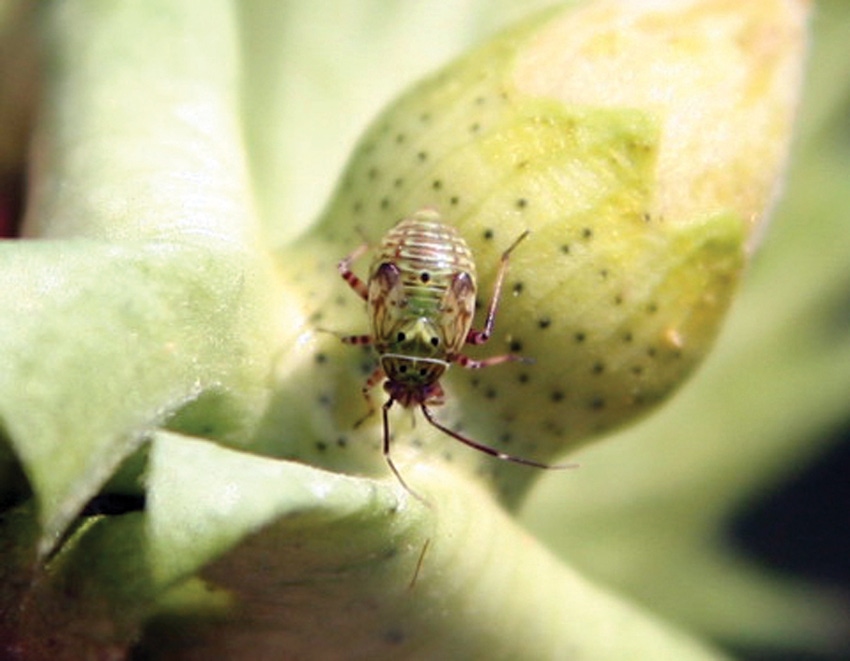
Lygus drained picker baskets and budgets in 2010
Nationally, the bollworm/budworm complex was the No. 1 pest of cotton in 2010.The total of cost plus loss for all insects was $974 million or $91.38 per acre.The Mid-South reported higher loss plus control costs than any other region and compared to the national average.

Lygus drained cotton picker baskets and budgets across much of the Mid-South in 2010, according to Cotton Insect Losses 2010, compiled by Michael Williams, chairman, Extension entomologist emeritus, Mississippi State University.
Lygus, or tarnished plant bug, was reported as the No. 1 most-damaging pest for Mississippi, Louisiana and Arkansas, and the second and third most-damaging pest for Tennessee and the Missouri Bootheel, respectively.
Nationally, the bollworm/budworm complex was the No. 1 pest, with losses of 1.186 percent reported. No other pest exceeded 1 percent loss. Stink bugs were ranked second at 0.724 percent, Lygus, third at 0.677 percent, cotton fleahoppers, fourth at 0.362 percent and aphids, fifth at 0.286 percent.
According to the survey, losses to all arthropod pests reduced overall U.S. yields by 3.91 percent last season, an increase over the 2.58 percent from 2009. Despite the increase, the losses represent another low estimate, reflecting a trend which began in 2000. Yield loss to insects averaged $35.33 per acre.
Direct management costs for arthropods were $56.05 per acre. The costs included: foliar insecticide costs, $22.56 per acre; at planting costs, $6.04; in-furrow costs, $3.55; scouting costs, $4.80; eradication costs, $5.08, and trangenic cotton, $14.01.
The total of cost plus loss for insects in 2010 was $974 million, or $91.38 per acre.
The Mid-South reported higher loss plus control cost than any other region and compared to the national average. Mississippi reported the highest loss plus cost to insects in the report at $227.32 per acre, followed by Louisiana, $190.55, Florida, $135.32, Arkansas, $134.70, and Tennessee, $127.51.
Insect pests reduced Mississippi cotton yields by 8.94 percent in 2010. Lygus decreased yield by 3.87 percent, followed by bollworm/budworm, 1.84 percent, and stink bug, 1.18 percent.
According to Mississippi State University Extension entomologist Angus Catchot, who was one of those surveyed for the report, higher insect control costs in Mississippi in 2010 were due to higher costs for chemicals and application.
“The cost of aerial and ground applications has risen due to fuel prices, plus the cost of chemistry has gone up, partly because we’re going to more tank mixes to combat resistance. Control of plant bug in the Delta region of the state has diminished due to resistance. We’re typically recommending tank mixing pyrethroids with our organophosphates after bloom.”
Catchot said cotton producers “are doing as good a job as they can in the absence of new chemistry to relieve some of the pressure. As long as we stay on top of it, we’re going to be spending more money. We may be spraying more, but at the end of the day, it’s worthwhile, given where cotton prices are. But we do need new modes of action.”
The high cost plus loss figure for Mississippi was skewed significantly by the Delta region. There, insects reduced yields by 9.92 percent compared to 5.02 percent for the Hill region. Total cost plus loss for the Delta region of Mississippi was $260.20 per acre compared to $111.33 for the Hill region.
Insect pests reduced Arkansas cotton yields by 5.71 percent in 2010. The top insect pest in terms of loss for Arkansas in 2010 was Lygus, at 2.74 percent followed by bollworm/budworm, 2.26 percent. No other pests mounted much of an attack on Arkansas cotton, according to the report. Lygus cost Arkansas cotton producers $18.06 per acre in treatment costs, far exceeding any other pest.
Insect pests reduced Louisiana cotton yields by 6.61 percent in 2010. The top insect pest for loss in Louisiana was Lygus, reducing yield by 4.1 percent, followed by bollworm/budworm, 1.28 percent. Cost of control for Lygus averaged $33.13 in the state, followed by bollworm/budworm, $24.84. These two pests accounted for most of the control costs per acre in Louisiana, according to the report.
Insect pests reduced Tennessee cotton yields by 5.71 percent in 2010. The top insect pest in terms of loss was stink bug, 1.6 percent, followed by Lygus, 1.5 percent, and spider mite, 0.84 percent. Cost of control for Lygus averaged $14.99 per acre, followed by stink bug, $8.53, spider mite, $6.01 and bollworm/budworm, $4.32.
Insect pests reduced Missouri Bootheel cotton yields by 2.27 percent in 2010. Missouri’s top pest in terms of loss was spider mite, 1.22 percent, followed by Lygus, 1 percent. Cost of control for Lygus was $10.51 per acre in 2010, followed by thrips, $4.84 and fall armyworm, $1.35.
By cotton type, Bollgard II cotton was planted on 6.4 million acres in 2010, herbicide-resistant-only cotton on 1.8 million acres, WideStrike cotton, 1.3 million acres, Bollgard, 734,000 acres, Pima, 174,000 acres and organic cotton, 13,000 acres.
In 2009, the top three pests of U.S. cotton were thrips, followed by Lygus and the bollworm/budworm complex
Information for the report was collected from surveys of county agents, Extension specialists, private consultants and research entomologists from all U.S. cotton growing regions.
About the Author(s)
You May Also Like





